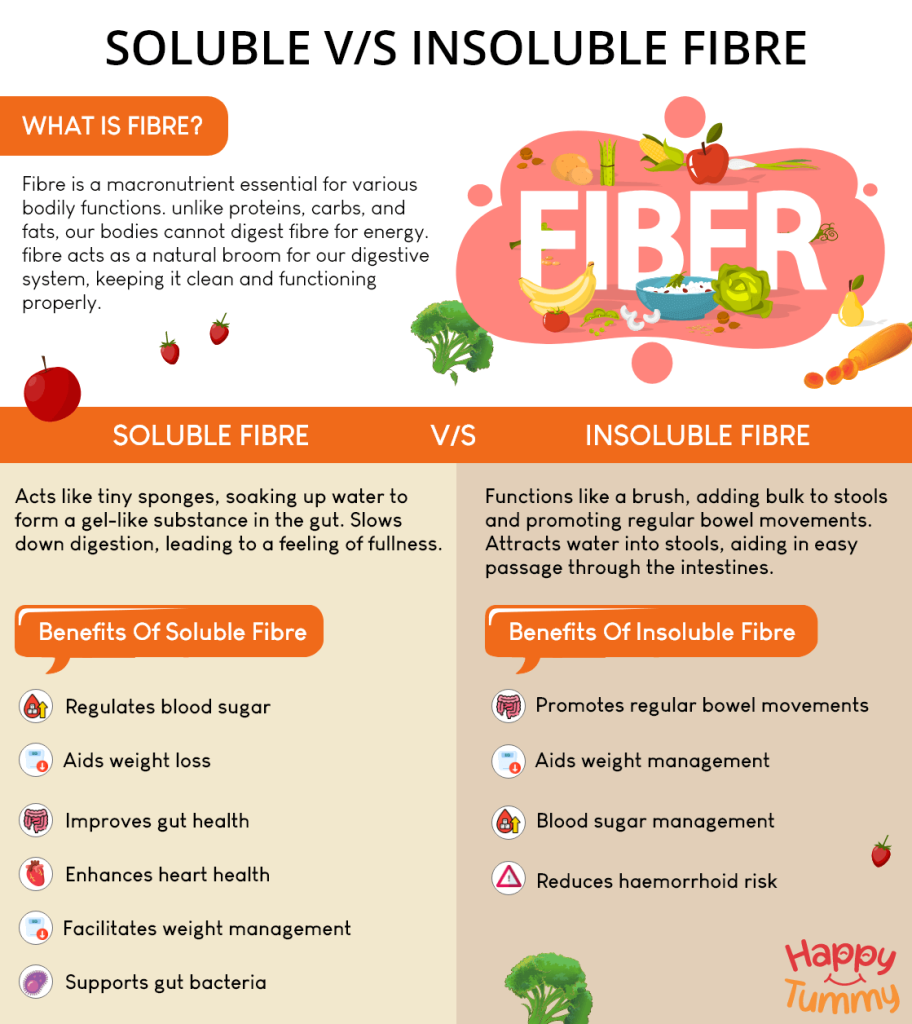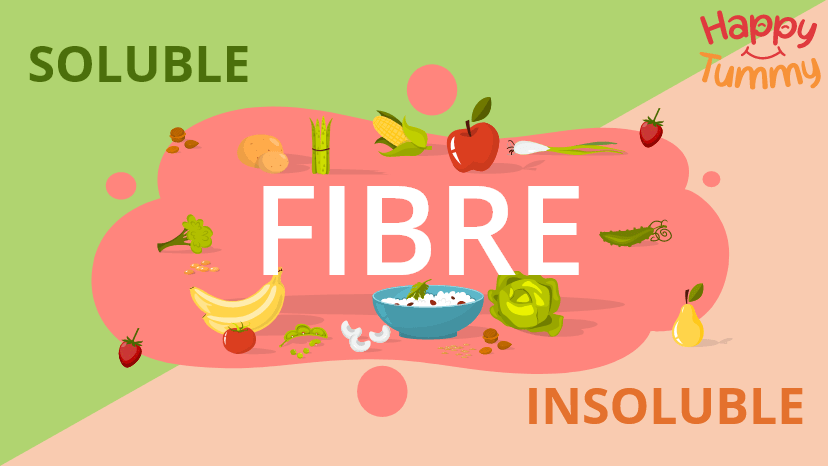Table of Contents
Most of us have heard well of fibre. But what do we know about this word beyond the fact that our bodies need it to stay healthy? Our knowledge ends here.
The world of fibre spans across two territories – soluble and insoluble fibre. Understanding the difference between these two fibre types is important because each of these offers distinct benefits for our digestive health and overall well-being. This empowers us to make better dietary decisions.
So, let’s fathom the fulsome world of fibre and see what lies inside, what benefits it offers, the many sources of soluble and insoluble fibre and when to consume each of these types.
What is Fibre?
To understand the difference between soluble v/s insoluble fibre, we must first know what fibre is.
Fibre, like protein, carb, and fat, is a macronutrient that our bodies need in adequate amounts to perform different body functions. Just as protein helps us in muscle building, hormone production, etc., fibre helps us too.
Fibre is made of long, stringy molecules like cellulose.
But here is a fun fact:
Our bodies can’t break down and digest fibre for energy production
Then why fibre?
We need fibre to keep our digestive systems clean and for several other reasons. It acts like a natural broom for our gut, keeping things clean and functioning properly. And this is where two types of fibre come into play – soluble and insoluble.

What is Soluble Fibre?
Simply imagine tiny sponges and brushes inside your digestive system. Soluble fibre is like tiny sponges. It soaks up water and forms a gel-like substance inside your guts. This creates weight and volume in your intestines. The result? We feel fuller for longer.
The name ‘soluble fibre’ simply tells that this fibre type easily gets dissolved in water. If you’ve observed something sticky in kidney beans, oats, or even ladyfinger, then you’ve seen soluble fibre.
But why soluble fibre?
Soluble Fibre Benefits
The main purpose of soluble fibre is to create a gel-like substance inside your intestines. This creates bulk and makes it move slowly through the guts. It’s this property that blesses us with numerous benefits. Here are a few:
- Because food moves slowly through the intestines, energy gets released at a slower pace. Consequently, blood sugar spikes don’t take place
- When blood sugar stays in balance, obesity remains under strong check and weight loss happens
- Also, because soluble fibre keeps us feeling full for longer, our timeless hungers stay away. In a way, we eat less and stay fit
- Soluble fibre also strengthens our guts and prevents several gut diseases such as IBS, constipation, bloating, etc.
- Also, its intake has been directly linked to improved heart health and lower cholesterol levels. This is great considering the rise of poor diet culture around the world [1]
Many studies have shown that those who took soluble fibre experienced fantastic weight loss, lower body fat, better BMI, and better waist-to-hip ratio. [2]
Some types of soluble fibre also get digested by healthy gut bacteria
This promotes their health, strength, and number. As a result, we get a good gut army that promotes digestion and elevates energy levels.
As we see, soluble fibre is a fantastic addition to the diet. However, many people tend to go for fibre supplements to meet their daily needs. Note that supplements should only be used as a support and under medical supervision and label instructions to avoid any negative implications . Only go for them when you are not able to get enough fibre through natural foods. And so, here are some foods that stay rich in soluble fibre:
Foods Rich in Soluble Fibre
- Oats
- Most millets such as bajra, ragi, jowar, barley, samai, etc.
- Kidney beans
- Apples
- Wheat
- Black gram
- Field beans/fava beans
- Soya beans
- Moringa leaves
- Drumsticks
- Ladies finger
- Figs
- Carrots
- Fenugreek seeds
- Curry leaves
- Coriander seeds
- Safflower seeds
And the list goes on. [3]
Now, let’s understand its counterpart – insoluble fibre.
What is Insoluble Fibre?
Unlike Soluble fibre, the insoluble fibre does not get dissolved in the water. Think of it as a brush rather than a sponge. Insoluble fibre has one purpose – to add bulk to your stools. Furthermore, it attracts water into stools. And by doing so, it helps stools pass easily through the intestines while taking with them the remaining build-up. This way, our intestines get cleaned. Simply think of it as roughage.
Most insoluble fibre is derived from the external skin/part of plants.
Just as soluble fibre offers numerous benefits, insoluble fibre helps us in numerous ways.
Insoluble Fibre Benefits
Because insoluble fibre is completely indigestible, it offers all its benefits indirectly. Here are a proven few:
- By adding bulk to stools, insoluble fibre promotes regular bowel movements and complete colon cleaning. This can prevent constipation and promote regular bowel movements
- Regular bowel emptying leads to better weight management as well
- Insoluble fibre also helps with blood sugar management. This means no control over unnecessary blood sugar spikes and the following obesity[4]
- By stimulating water secreting inside our guts, insoluble fibre also reduces the chances of haemorrhoids by as much as 50% [5]
Now, what are some foods that offer rich insoluble fibre?
Foods Rich in Insoluble Fibre
- Coriander seeds
- Fenugreek seeds
- Mint leaves
- Curry leaves
- Yam
- Red Carrot
- Tamarind
- Soya beans
- Rajma / Kidney beans
- Peas
- Bengal gram
- Most whole grains
- Sapota
- Dry raisins
- Pears
- Guava
- Gooseberry
- Dates
- Avocado
- Drumsticks
- Field beans [6]
These are some of the foods that contain insoluble fibre in high amounts. But how much fibre should be consumed each day to ensure health and well-being?
How Much Fibre In A Day?
Today, out of 10 Indians lack enough fibre in their diet. This leads to poor health and a shorter lifespan.
According to the recent RDA (2020) the daily Dietary Fiber intake varies with Age, Gender & Physical activity as follows-
| Age | Category of Work | Dietary Fiber (g/d) |
| Man | Sedentary | 30 |
| Moderate | 40 | |
| Heavy | 50 | |
| Woman | Sedentary | 25 |
| Moderate | 30 | |
| Heavy | 40 | |
| Children | 1-3y | 15 |
| 4-6y | 20 | |
| 5-7y | 26 | |
| Boys | 10-12y | 33 |
| 13-15y | 43 | |
| 16-18y | 50 | |
| Girls | 10-12y | 30 |
| 13-15y | 36 | |
| 16-18y | 38 |
However, know that fibre, although necessary, must be consumed in moderation. Too much fibre can backfire and make you feel bad.
Taking too much fibre can lead to bloating, gas, stomach pain, etc. However, the chances of fibre overdose are close to none unless you go for fibre supplements, which are not recommended until utterly necessary.
And now the question that many try to get answers to – How much soluble and insoluble fibre?
Although there are no dietary recommendations regarding this yet, many experts suggest getting 1/4th of your fibre intake as soluble fibre, which is 6-8 grams. However, don’t focus too much on these numbers. [7]
The best way to increase fibre intake is to have a colourful plate. How? By including several fruits, vegetables, grains, etc. on your plate. Never depend on one food alone. A study done on blue zones (areas where people live longest) found that those living there enjoy a wide range of naturally occurring foods. Furthermore, their fibre intake was fantastic.
- Try including whole grains in your diet. Replace a few meals of rice and pasta with whole grains such as barley, wheat, etc.
- Consume more lentils and dry beans (kidney beans, field beans, etc.). This will not only bless you with fibre but also lots of protein.
- Eat more fruits and vegetables. If possible, try to use the peel of vegetables because they stay rich in fibre. However, ensure that the produce has been grown organically without the use of any pesticide or fungicide.
- Cook oats on a few occasions. If you don’t like the taste, try to be creative and give it an Indian touch
And now, it is time for some precautions:
- While buying foods with added fibre, read the ingredient list and ensure that it has not been derived from foods that you might be allergic to
- When giving fibre supplements to a child, always consult a paediatrician first
- Avoid canned items as they might be high in sodium and preservatives as well
Apart from that, you are good to go.
So, here is the brief of soluble vs insoluble fibre in a nutshell.
| Feature | Soluble Fiber | Insoluble Fiber |
| What it is | Like tiny sponges that soak up water and form a gel-like substance | Like a brush that adds bulk to stools and helps clean guts |
| Benefits | Creates a feeling of fullness, regulates blood sugar, improves heart health, controls hunger | Promotes regular bowel movements, prevents constipation, reduces chances of haemorrhoids |
| Found in foods | Oats, kidney beans, apples, barley, etc. | Wheat bran, nuts, seeds, vegetables and fruits with peels intact, etc. |
Conclusion
Today, 7 in 10 Indians lack enough fibre in their diet. This is alarming considering the falling health around. Including fibre in the diet offers numerous health benefits such as blood sugar control, better weight, reduction in cholesterol, a feeling of fullness, stronger digestion, regular bowel movements, better heart health, and whatnot. The list is long.
However, as important as it is to consume fibre, understanding the different types is equally important. Where soluble fibre forms a gel-like substance and makes food move at a smoother pace, thereby controlling blood sugar, insoluble fibre adds bulk to stools and helps clean intestines like a brush.
While there’s no set guideline on the split between soluble and insoluble fibre intake, incorporating a variety of colourful fruits, vegetables, and whole grains into your diet is a great way to ensure you’re getting enough of both! Remember, a balanced and diverse diet is key!
So, are you fibre-ready now?
FAQs
There isn’t a single “best” type, aim for a variety of both! Try including lots of vegetables, fruits, whole grains, dry beans, etc as they are good sources of fibre.
There are just two main types: soluble and insoluble. However, many people even consider prebiotic fibre to be a third type, which actually is a soluble fibre.
Although both fibre helps have better bowel movements, insoluble fibre adds bulk and aids in constipation relief.
Oats, apples, kidney beans, and barley are all good sources of soluble fibre.
Eating too much fibre can cause symptoms such as gas, bloating and diarrhea.
















